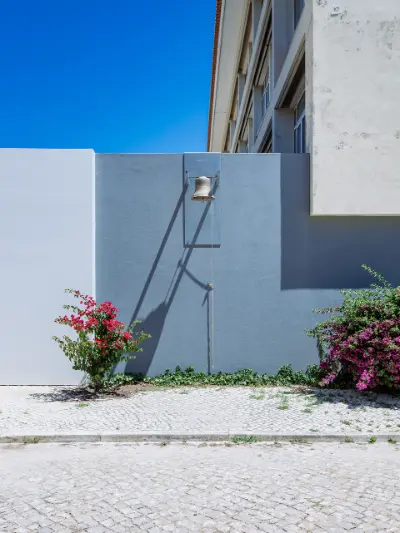耶稣大师小教堂

下载所需积分: 2
这是一座小教堂,或称小礼拜堂,建造在特定的房屋中,服务于特定的人群——圣保罗传教会的兄弟会。项目的简要说明基于一些不一定一致的原则:它应该是一个多家庭住宅的中心区域;一个祈祷和交流的空间;一个既亲密又适合集会的地方。
这座奉献给耶稣大师的小教堂位于里斯本郊区的阿佩拉桑,坐落在“使徒女王庄园”内。这是一个乡村地块,俯瞰着开阔的山谷,面向塔霍河,传教会自1970年代以来一直在此地。现有的建筑群包括一对长的四层楼块,坐落在一个原本用作仓库的底层平台上。这个区域被选为小教堂的地点,利用其在生活、工作、接待和祈祷空间中的中心位置。因此,小教堂在物理和象征上都作为传教会的核心;它为兄弟会成员提供了联系,并通过他们的出版/传教活动与更广泛的平信徒社区建立联系。
该项目重新利用现有建筑,旨在赋予其新的意义;这一过程通过严谨而简朴的设计实现,依赖于体量的简单性、自然采光和所提议材料的固有特性。混凝土结构被保留,裸露且不完美,但仍然适用,并在新的环境中得到了提升。房间呈现为一个整体而宽敞的空间,没有华丽或过度的装饰:这是一个为礼仪设备提供背景的空间,增强并赋予神圣和神学的意义。
其中,中央祭坛尤为突出。祭坛由实木制成,没有明确的祭司区——这是一个为所有人服务的地方,没有等级之分。与讲坛结合,这允许礼仪庆典有多种布局和不同程度的亲密感:与社区兄弟围绕祭坛进行的私人庆典 “朝北/南方向”;与平信徒集会的定期庆典 “沿纵向轴线布置,庆祝者面向西方”;以及充满小教堂的节庆庆典 “朝北/南方向”。
十字架被设计为庆典和建筑的一个整体部分。它通过一个互锁的接头与混凝土结构物理连接,但可以分离以便在游行中携带,从而标志着庆典的开始和结束。
内部空间由两个木工元素强烈标记,均具有明确的礼仪功能:位于西侧的祭衣间,包括面向花园的忏悔室,以及位于南侧的隔墙,框架描绘耶稣的苦路。这面墙并没有完全封闭小教堂:它允许通过后面的走廊一瞥,感知整个房间,从而提供与现有建筑之间的连接。
北侧的外部空间复制了小教堂的体量。这个区域不仅仅是一个花园,而是作为祈祷空间的延伸而设计。通过几何形状和材料性,它成为整体的一部分,为简约的建筑群增添了水和植被。小教堂的公共入口位于南侧,由一扇带有雕刻十字架和铃铛的木门标识,二者均符合项目的一般原则。
项目要求包括该兄弟会特定信仰的描绘。这些从一开始就被视为设计的一部分,而不是后来的附加内容。原始艺术作品由巴尔托洛梅乌·德·古斯芒 “Bartolomeu de Gusmão” 现场创作,绘制在墙面和木工表面上,创造了空间与宗教社区之间强烈而整体的关系。空间及其内部元素共同向使用者传达了明确而重要的信息——强化了原始委托所蕴含的归属感和分享感。
This is a chapel, or a small church, built in a particular house for particular people – the brotherhood of Instituto Missionário Pio Sociedade de São Paulo. The project brief is based on principles that don’t necessarily concur: it should be the central area for a house of many homes; a space for prayer and for communication; a place of intimacy as well as assembly.
The chapel, consecrated to Jesus Master, sits within Quinta Rainha dos Apóstolos, in Apelação, on the outskirts of Lisbon. This is a rural plot, overlooking a broad valley open to the river Tagus, where the Institute has been located since the 1970s. The existing complex includes a pair of long 4-storey blocks sitting on a ground-floor podium, originally used as a warehouse. This was the area chosen to locate the chapel, taking advantage of its central position in relation to the spaces where to live, to work, to welcome and to pray. The chapel therefore operates as the heart of the Institute, both physically and symbolically; it provides the link between members of the brotherhood and reaches the wider lay community through their publishing/ missionary activities.
The project reuses the existing building and aims to provide it with a new meaning; this is done through a process of austere and rigorous designing, which relies on the simplicity of volumes, natural lighting and inherent qualities of proposed materials. The concrete structure is retained, bare and imperfect but suitable nevertheless, and somehow up-lifted by the new context. The room is revealed as a whole and wide space, without artifice or excess: a backdrop for the liturgical fittings to enhance and impart with a sacred and theological sense.
Among those, the central altar stands out. This is built in solid timber, with no delineation of presbytery - a place for all, without hierarchies. In conjunction with the pulpit, this allows a wide range of layouts and different degrees of intimacy for liturgical celebrations: private celebrations with community brothers gathered around the altar with the garden behind (orientation north / south); regular celebrations with lay assembly (placed along the longitudinal axis with the celebrant facing west); and festive celebrations that fill the chapel (orientation north / south).
The Cross is designed as an integral part of the celebrations and the building. It is physically connected to the concrete structure through an interlocking joint, but can be disengaged to be carried in procession, thus marking the beginning and the end of celebrations.
The internal space is strongly marked by two joinery elements, both with clear liturgical function: the sacristy to the west side, which includes the confessional booth open to the garden, and the partition wall to the south side, which frames the depictions of Jesus Way of the Cross. This wall does not enclose the chapel completely: it allows for the room to be perceived as a whole, through glimpses of the corridor behind it providing connection between the existing buildings.
The external space to the north replicates the volume of the chapel. More than a mere garden, this area is designed as an extension to the praying space. Part of the whole through geometry and materiality, it adds water and vegetation to the simplicity of the set. Public access to the chapel is granted from the south, identified by a timber door with an engraved cross and a bell, both designed in line with the general principles of the project.
The brief required depictions of particular devotions of this brotherhood to be included. These were considered from the start as part of the design, instead of later additions. Original art work was executed in situ by Bartolomeu de Gusmão, on walls and joinery surfaces, creating an intense and global relationship between the space and the religious community. Together, the space and the elements that populate the space convey a clear and critical message to its users – reinforcing the sense of belonging and sharing that imbued the original commission.